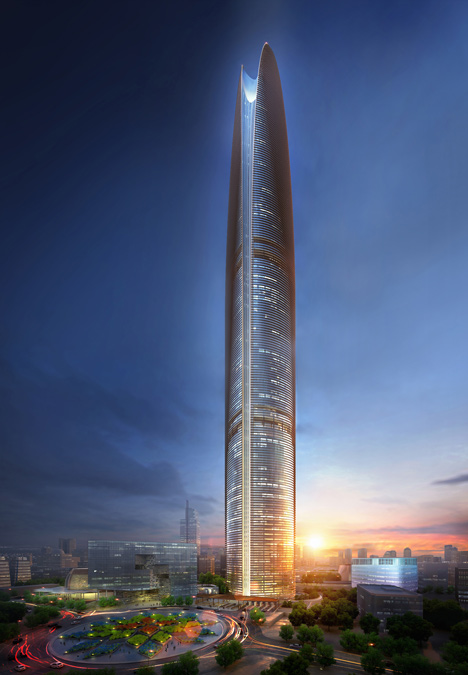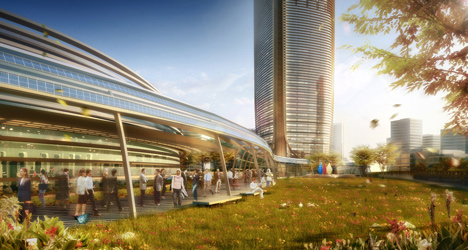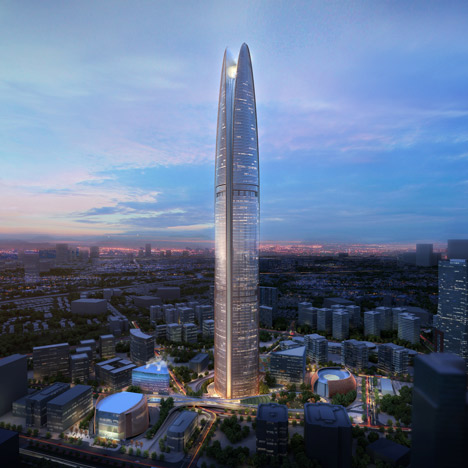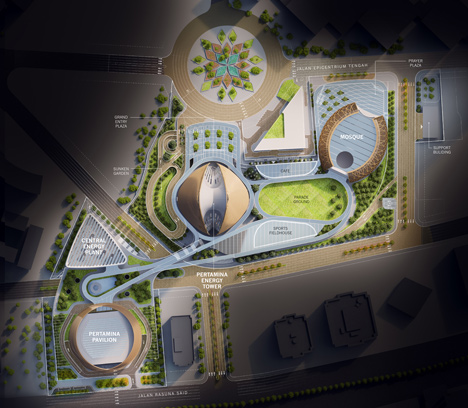SOM unveils Indonesian skyscraper that will harness wind power
News: American firm Skidmore, Owings & Merrill (SOM) has revealed designs for a skyscraper in Jakarta that will be over 500 metres high and will harvest wind energy through an opening at its peak.
With a proposed height of approximately 530 metres, the Pertamina Energy Tower will be twice as high as Wisma 46, currently the tallest building in Indonesia, and will feature an integrated "wind funnel" that generates energy from prevailing air currents.

SOM designed the building as a headquarters for state-owned oil and gas corporation Pertamina and it will be constructed as part of a proposed campus that also includes a mosque, a performing arts and exhibition centre, sports facilities and an energy plant.
The exterior of the tower will be glazed and will gently taper towards the top to frame the opening of the wind funnel. This curved facade will feature solar shades to allow natural light to enter, without the problems of solar heat gain.

"Pertamina Energy Tower's iconic presence will stand as a model of sustainability and efficiency, as well as collaborative workplace design," said SOM director Scott Duncan.
"The headquarters' performance-driven design supports and reflects the ambition of Pertamina's mission and forges an innovative model of green development in Jakarta."

The building is scheduled for completion in 2020 in Jakarta's Rasuna Epicentrum neighbourhood and will accommodate up to 20,000 Pertamina employees.
It is the latest in a string of skyscrapers proposed recently for the Indonesian capital, including a 400-metre structure designed by MVRDV to look like a pile of buildings.

More information from SOM is included below:
Pertamina reveals plans for SOM-designed tower in Jakarta
Plans were unveiled on Monday for Pertamina Energy Tower, a highly sustainable corporate headquarters in Jakarta, designed by Skidmore, Owings & Merrill LLP (SOM), the renowned architecture, engineering, interiors and planning firm. Created for the state-owned energy company, Pertamina, the large-scale project will feature a performing arts and exhibition pavilion, a mosque, and a central energy plant in addition to the office tower. Rising more than 500 metres above Jakarta, the tower will be a new landmark on the capitol's skyline.
The architectural expression of Pertamina Energy Tower reinforces the sustainable strategies at the core of its design. Gently tapering towards a rounded top, the tower opens up at the crown, revealing a 'wind funnel' that will take advantage of the prevailing winds and increased wind speeds at the upper floors to generate energy. Precisely calibrated for Jakarta's proximity to the equator, the tower's curved facade will mitigate solar heat gain throughout the year. Exterior sun shades will dramatically improve the workplace environment and save energy by reducing the need for artificial lighting in the office interiors.
The 99-story tower will accommodate 20,000 employees and will be the centrepiece of the Pertamina campus in Jakarta's Rasuna Epicentrum neighbourhood. Conceived as a city within a city, the campus design endeavours to create a new model for a corporate headquarters – one that is more like a bustling city – with vibrant public spaces and communal meeting areas, such as a 2,000-seat auditorium for lectures and performances and a public mosque. A central energy plant will serve as the energy production hub for the campus, a literal and figurative "heart" from which energy and services will be distributed. A covered walkway known as the "Energy Ribbon" will knit together the constellation of campus programs and span across land bridges and gardens to create an array of accessible public spaces. The project is slated for completion in 2020.